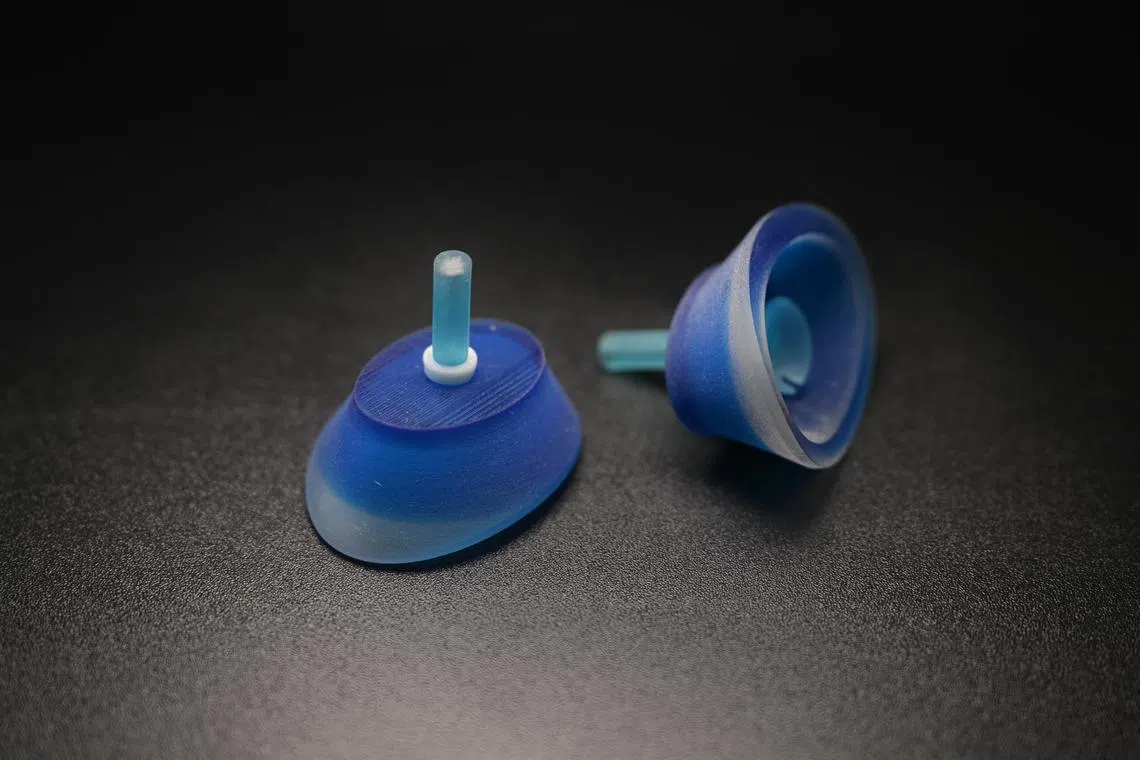Tool to help kids wear contact lens with ease wins $50,000 Duke-NUS grant
Sign up now: Get ST's newsletters delivered to your inbox

The group estimate that the contact lens applicator can potentially reduce the duration of tutorials to under 30 minutes.
ST PHOTO: MARK CHEONG
Follow topic:
SINGAPORE – Putting on contact lenses for the first time can be challenging – even more so for children.
Ms Yan Ng, 49, said her youngest daughter, Colette, who was 10 at the time, struggled whenever her mother’s finger approached her eye to apply a corrective contact lens – a hard lens designed to reshape the wearer’s cornea and slow down the progression of short-sightedness.
Ms Ng, a human resources consultant, performed this routine twice daily – once in the evening before her daughter went to bed and again in the morning to remove the lenses – until Colette, now 13, finally learnt to do it herself about four months later.
“She couldn’t stay still at the start,” the mother of two told The Sunday Times. “She wasn’t used to having something pushed towards her eye, so she would keep on blinking. It was a bit of a struggle at first.”
Such a struggle is likely to go away soon, now that researchers have created a pocket-size prototype to make it easier for children to put on contact lenses.
On March 19, the team of three won a $50,000 grant during the third run of the annual Duke-NUS Health Innovator Programme challenge, paving the way for commercial use. With the grant, the team aims to refine its prototype, with plans to start clinical trials by 2026.
The team’s clinical mentor, Singapore National Eye Centre eye specialist Foo Li Lian, was drawn to the project to encourage the adoption of hard contact lenses, which are typically worn overnight to shape the cornea and slow down the progress of myopia. After a few hours overnight, the user can typically go a whole day without needing to wear glasses.
Corrective contact lenses are more effective in slowing down the worsening of a child’s short-sightedness, said Dr Foo.
Today, there are an estimated two million myopic adults in Singapore the myopia capital of the world

(From left) Singapore National Eye Centre eye specialist Foo Li Lian, NUS MBA student Melody Kwok, NUS biomedical engineering student Lakshmi Sujeesh and Duke-NUS Medical School student Charles Yau started on the project in 2024.
ST PHOTO: MARK CHEONG
Dr Foo said corrective contact lenses, called orthokeratology (or Ortho-K) lenses, can slow down the rate or progression of myopia without surgery, but most families opt for glasses due to hygiene, fear of contact lenses and difficulty in inserting them.
She estimated that while the adoption rate is steadily increasing, only up to 10 per cent of her patients pick myopia-control contact lenses, which are custom-made for the wearer and typically cost $1,500 or more for a year’s supply.
The team, comprising Duke-NUS Medical School student Charles Yau, 30; NUS biomedical engineering student Lakshmi Sujeesh, 23; and NUS Master of Business Administration student Melody Kwok, 35, started on the project in 2024 to make wearing contact lenses less of a struggle.
How it works
Their 3D-printed tool comprises a small plunger connected to an oval cup that fits around the child’s eye to prevent blinking while the lens is being applied.
The oval cup also obstructs the child’s view, which helps to ease the fear of an object coming near the eye, said Ms Sujeesh.
A hard or soft contact lens, attached to a suction cup at the end of the plunger, can be gently pushed towards the child’s eye to position it correctly. A stopper attached to the plunger stops the stick from being pushed too deeply towards the eye to prevent injury.
The kit includes a cleaning cylinder to scrub the contact lenses thoroughly to reduce the risk of eye infections.
The group estimates that the contact lens applicator can potentially reduce the duration of tutorials to under 30 minutes.
“The learning curve can be steep, and training can take anywhere from 30 to 90 minutes,” Dr Foo said. “In some cases, patients may even require more than one session.”
Ms Ng said that a device like this would likely have made the process of teaching her daughter how to put on contact lenses much smoother.
She opted to have Colette wear corrective lenses to slow the progression of her myopia, which had been worsening by some 100 degrees each year since Colette started primary school.
Since using the lenses each night, Colette’s prescription has stopped progressing and remained under 375 degrees, said Ms Ng.
Not having to wear glasses made it easier for Colette to play, swim and participate in outdoor activities too, she added.


